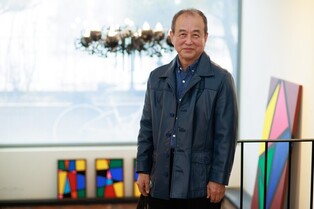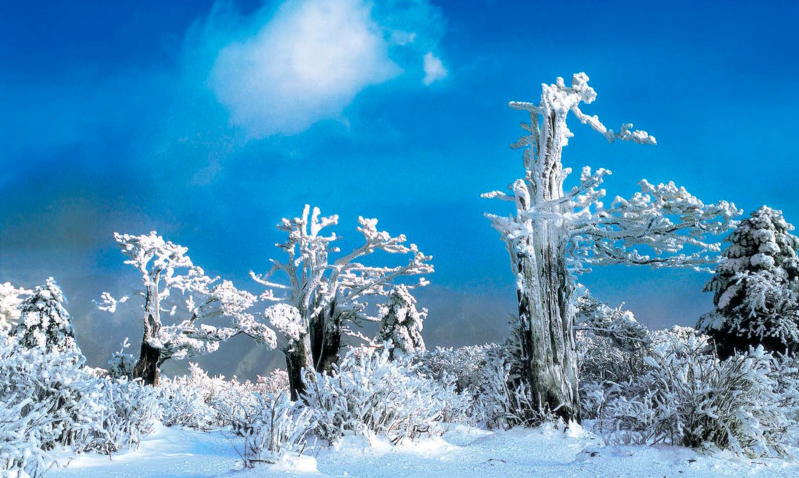 |
| ▲ Snow-covered yew trees in Taebaeksan (Mt. Taebaek), Gangwon Province. (Yonhap) |
Fairy tale winter wonderland in snow-covered Taebaeksan
The word “Taebaek (태백)” in Taebaeksan (Mount. Taebaek) means “grand brightness (太白).”
As the first of the “bright mountains (baeksan),” Taebaeksan holds the significance of being the “largest and brightest mountain.” It is also known as “Hanbakmyo” or “Hanbaedal.”
In this sacred mountain of the Korean people, Taebaeksan, there are several peaks known as Janggunbong, Buseobong, Yeongbong, Wonsulbong, Munsubong, Gamabong, and Horongbong.
Janggunbong, the highest peak of Taebaeksan, stands at an elevation of 1,568 meters, located 300 meters north of Yeongbong, where the “Cheonjedan (Heavenly Altar)” is located.
At the summit of Janggunbong, there is a square stone altar built with natural rock called Gyuam. It is named Janggunbong because, like the Soldier Peak of Baekdusan (Mount. Baekdu), it holds a significance of serving a ritual to the heavenly general at the peak.
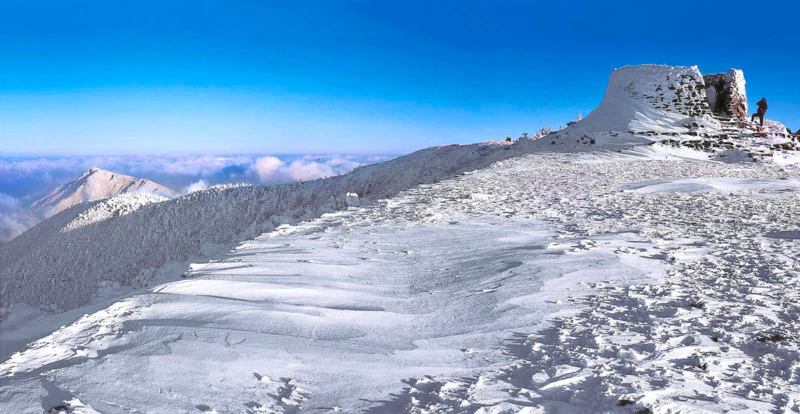 |
| ▲ Cheonjedan ("Heavenly Altar") in Taebaeksan, Gangwon Province. (Yonhap) |
Taebaek City, cradled by Taebaeksan, boasts a high-altitude plateau with cool summer nights without tropical nights and stunning winter landscapes.
Despite the winter in the plateau city of Taebaek being notably long and cold, every January brings the exciting Taebaeksan Snow Festival, capable of dispelling the sub-zero chill.
The winter scenery of Taebaeksan is enough to thrill winter mountain enthusiasts. As the new year arrives, people line up with their wishes, climbing the mountain in a collective act of goodwill. Ascending the mountain, one encounters thick snow covering the landscape, with snowflakes, ancient pines, and white snow creating an enchanting view of Taebaeksan.
There are also merry snow festivities that captivate one’s mind. It feels as if stepping into a fairy tale world, with the snow-covered landscapes creating a breathtaking spectacle.
The foothills of Taebaeksan lead to the “Untan-godo 1330, 6-gil,” a path through the Jijigol pine forest. The term “Untan-godo” refers to a route established in the past for transporting coal, originating from the Chinese term “Cha Ma Godo.”
“Untan-godo 1330” covers a total length of 173.2 kilometers, averaging an altitude of 546 meters, encompassing abandoned mining areas in Gangwon Province, including Taebaek, Samcheok, Jeongseon, and Yeongwol.
For those looking for a light hiking course, simply taking a refreshing stroll along the path can provide a healing experience, enjoying the cool air all the way to rejuvenating the respiratory system.
The trail “Untan-godo 1330, 6-gil” includes Taebaek Athletes' Village, Otou Observatory, Jijigol, and Industrial Heritage Monument Site. This connects to “Untan-godo 1330, 7-gil,” leading to Daejosan, Yongjeong Village, Naktongjeongmaek, Tongli Station, and Miin Waterfall.
In the Samguk Sagi's Silla Annals, there
is a record stating that King Ilsung of Silla ascended Taebaeksan in October of
the year 138. In 1991, Cheonjedan Altar was designated as the National Folklore
Cultural Heritage No. 228.
The city of Taebaek has been actively developing civic participatory cultural events such as the Taebaeksan Cheonje Parade and mountain-top music concerts.
These efforts earned the city recognition as one of the “Local 100 (Local Cultural Charms 100)” by the Ministry of Culture, Sports and Tourism in October of the previous year.
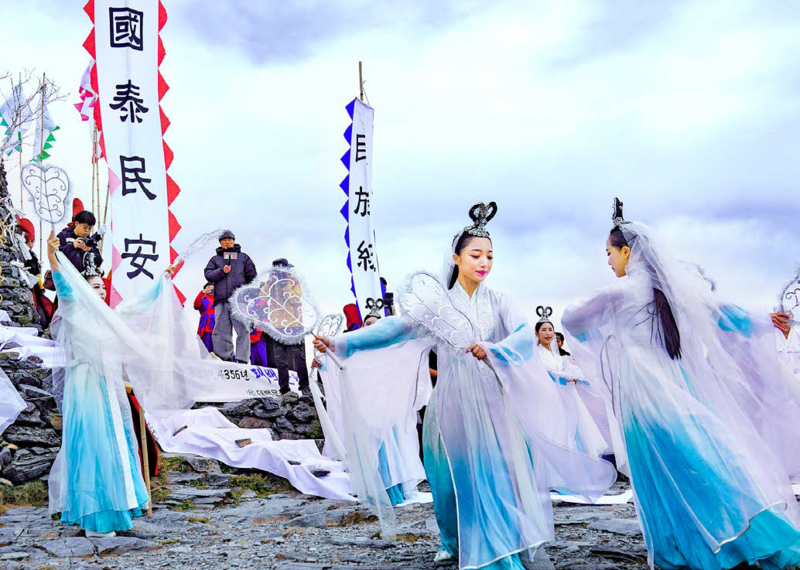 |
| ▲ "Cheonje-bonghaeng," or a heavenly ritual to celebrate the National Foundation Day. (Yonhap) |
Meet fantasy winter wonderland in “Taebaeksan Snow Festival”
The Taebaeksan Snow Festival is the representative winter festival of the snow city, Taebaek. It is filled with unique attractions and entertainment that showcase the charm of Taebaek.
Since its inception in 1994, the festival, soon to celebrate its 31st edition, features the dazzling and magnificent snow sculptures displayed at the Dangol Square in Taebaeksan National Park, as well as a large igloo cafe.
Various artworks await tourists around Dangol Square at Taebaeksan National Park. The large snow sculpture exhibition is a popular event representing the Taebaeksan Snow Festival.
Every year, different themes are chosen, and the completed snow sculptures, crafted through competitions by university students and the dedicated work of professional artists, reject comparison in terms of scale and artistry.
Large snow sculptures reflecting the zeitgeist of their times, such as “King Kong” in 2006, “Gwanghwamun” in 2009, and “PSY” in 2013, garnered immense popularity. The 30-meter large igloo cafe, equipped with ice tables and more, exudes a winter atmosphere, providing festival visitors with delightful memories.
The 30th Taebaeksan Snow Festival, held under the theme “Strange Fairytale Land -- Taebaek Village,” attracted a crowd of some 320,000 people.
The 31st Taebaeksan Snow Festival is scheduled to take place from January 26 to February 4 in 2024. Visitors are most welcome to the pinnacle of fantastic winter landscapes at the Taebaeksan Snow Festival in 2024.
Hwangjiyeon Pond, located 10 ri west of Taebaeksan, is formed by the convergence of various mountain waters flowing towards the southwest, piercing through the mountains and becoming the source of the Nakdong River, known as “Cheoncheon (天川),” marking the beginning of the 1,300-ri-long Nakdonggang River.
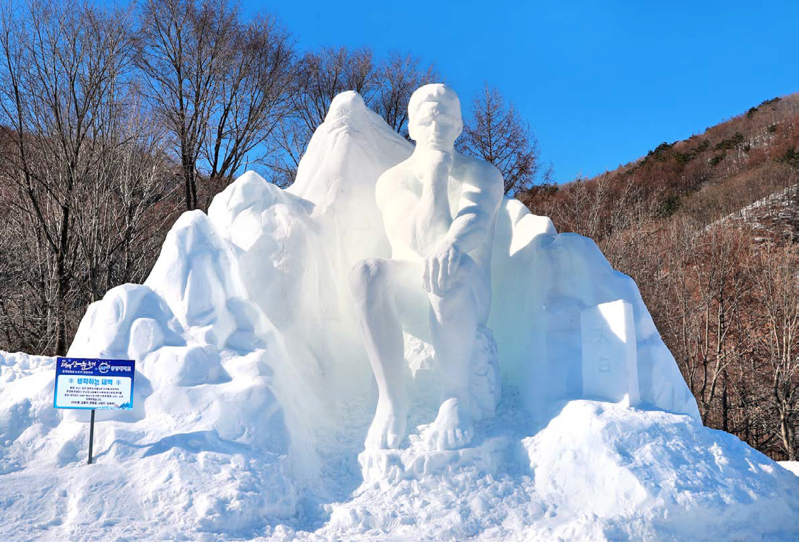 |
| ▲ One of the ice sculptures by college students at Taebaeksan Snow Festival. (Yonhap) |
Taebaeksan Cheonje, dubbed “Local 100” by culture ministry
Taebaeksan is associated with the founding myth of Korea, or the “Dangun Myth.”
According to the Samguk Yusa's account in the Goguryeo era, the son of the Heavenly Lord (Hwanin), Hwanung Cheonwang, descended to Taebaeksan's divine altar and built the Divine City (Shinshi). Later, he married a bear-woman (Wungnyeo) and from this union, Dangun was born.
Therefore, Taebaeksan, where the Heavenly Lord's son descended, was considered a path leading to heaven, and it became a place believed to be a ladder to heaven. The myth led to the time-old tradition to climb Taebaeksan and hold ceremonies in heaven.
Every third of October on Gaecheonjeol (National Foundation Day), a Cheonje (Heavenly Ritual) is conducted. In the ceremonial event, people pray for world peace, national unity, prosperity, and favorable winds and rain.
(C) Yonhap News Agency. All Rights Reserved























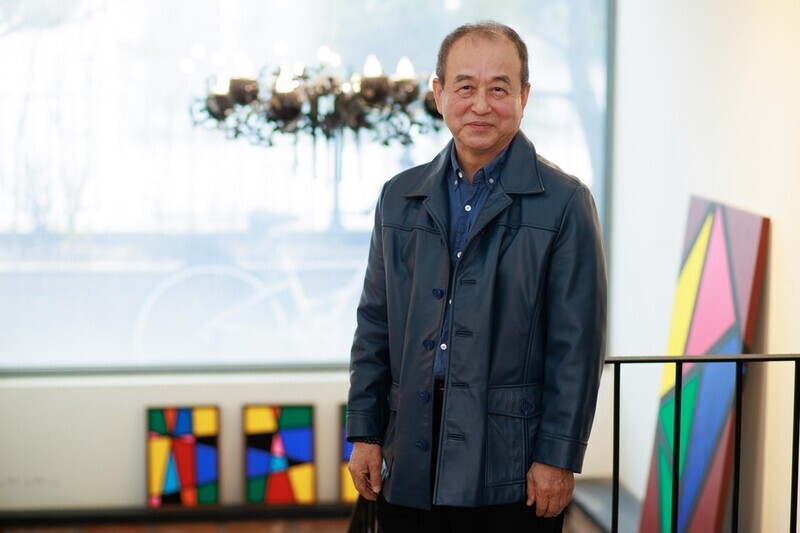

![[가요소식] 보이넥스트도어, 신보로 3연속 밀리언셀러 달성](/news/data/20251025/yna1065624915905018_166_h2.jpg)
